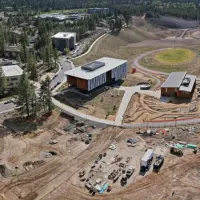
Oregon State University – Cascades has been recognized for its novel approach to remediating the former Deschutes County demolition landfill and pumice mine, and transforming them into buildable land for the growing campus.
OSU-Cascades is one of 10 award winners across the country recognized by the U.S. Environmental Protection Agency and the International City/County Management Association for innovative approaches in transforming brownfield sites.
A brownfield is an underused piece of land wherein redevelopment is complicated by environmental issues. Brownfields often remain undeveloped and blighted parcels of land because of environmental concerns or costs associated with clean up.
OSU-Cascades’ remediation efforts began in 2018, more than two decades after the county landfill had closed. Before those efforts began, the site was considered a human safety liability because of the risk of sink holes forming and intense heat, up to 500 degrees Fahrenheit, generated as materials decomposed.
OSU-Cascades’ approach to the remediation was developed by environmental engineers with Maul Foster & Alongi and entailed re-using excavated and processed landfill waste to create useable soil. That soil was then transferred to the former pumice mine, raising the 100-foot floor by 40 feet.
This strategy minimized the cost of the project by eliminating large-scale off-site waste transport and import of fill materials, diminishing truck traffic and other potentially negative neighborhood impacts. To date, OSU-Cascades has made usable 25 acres of the 72-acre landfill, and more than 20 acres of the 46-acre pumice mine.
Edward J. Ray Hall sits atop remediated portions of the pumice mine; the Student Success Center and land undergoing preparation for the first phase of the innovation district sit atop remediated portions of the landfill.
Local and Oregon contractors Taylor Northwest, Knife River, GRI and Carlson Geotechnical also contributed to the effort.
In addition to the EPA, campus planners work with the Oregon Department of Environmental Quality, Deschutes County and community stakeholders during the remediation process.
The county landfill began operation in 1972 and accepted demolition debris including wood, sawdust and boiler ash from the Brooks-Scanlon and Shevlin-Hixon timber mills, which were located on properties that now make up the Old Mill District.
The remediation projects have been funded by the EPA, State of Oregon and OSU.














